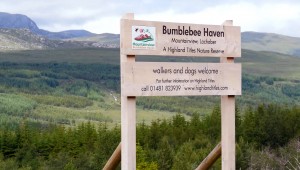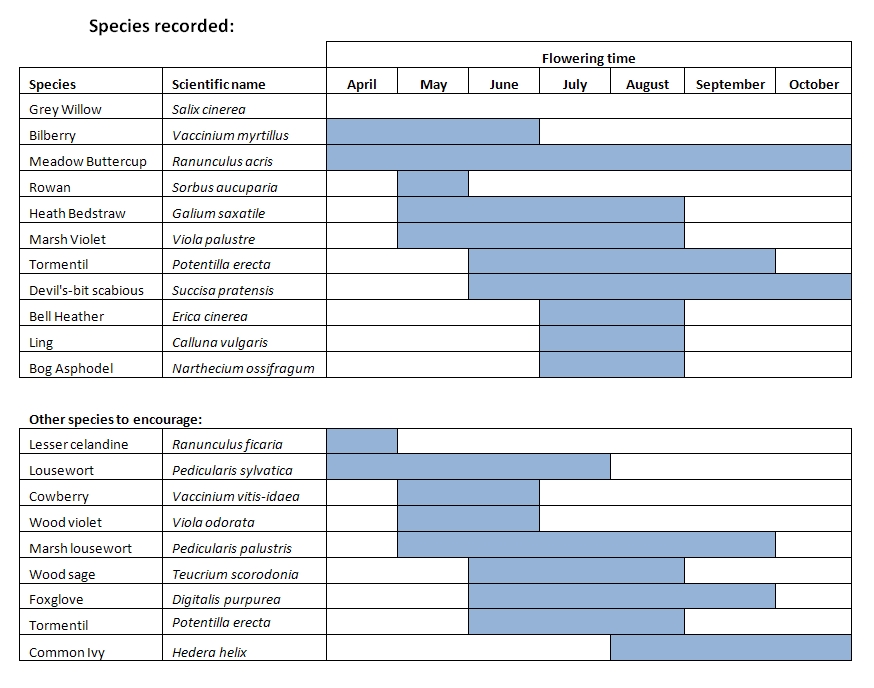Bumblebee Haven
One of the Highland Titles Nature Reserves
This land is dedicated to the conservation of Bumblebees. The Great yellow bumblebee Bombus distinguendus is now only found on the north coast and islands of Scotland, and in Ireland.
It was planted between 1987-1988 as part of the Ardochy Forest Complex, which extends to the south and west. The overall area was enclosed within a ring fence to exclude deer and livestock and aid establishment. More recently, the fence has been opened up with the removal of the deer grid on the public road, allowing Red and Roe deer to inhabit the woodland. Approximately 10 years’ ago, several small enclosures were created on unplanted land, which was then planted with a mixture of native broadleaves and Scots pine, enriching the woodland with a more diverse tree species
Once Scotland was entirely covered in forest. Today only 1% of Scotland retains its native woodland. Almost all of the remaining native woodland has, at some time, been modified by man’s activities, and yet the profusion of flowering plants, mosses, lichens, fungi, and myriad animals (mostly insects and other invertebrates) make them one of Scotland’s richest wildlife assets.
After the end of the last ice age, Britain was colonised first by birch, followed by hazel, pine and oak with woodland cover around five thousand years ago extending to Shetland and the Western Isles. After that, woodland cover began to reduce, largely from early agriculture, and by the first century, half of the natural woodland had disappeared, including the native woodland covering Bumblebee Haven. The woodland was replaced by heather moorland, probably caused partly by climate and partly by human activities, which provides excellent habitat for bumblebees.
 By the end of the 19th century interest in native woods was in decline and woodland covered less than 4% of Scotland’s land area, fragmented into many small and isolated blocks. This process of habitat loss and degradation led inexorably to the loss of species requiring larger unbroken blocks of native woodland – and especially of the larger mammals and predators.
By the end of the 19th century interest in native woods was in decline and woodland covered less than 4% of Scotland’s land area, fragmented into many small and isolated blocks. This process of habitat loss and degradation led inexorably to the loss of species requiring larger unbroken blocks of native woodland – and especially of the larger mammals and predators.
Many bumblebee species have been recorded within 10km of Bumblebee Haven, including:
- Early bumblebee (Bombus pratorum)
- Gypsy cuckoo bee (Bombus bohemicus)
- Common carder bee (Bombus pascuorum)
- Broken-belted bumblebee (Bombus soroensis)
- Blaeberry Bumblebee (Bombus monticola)
- White tailed bumblebee (Bombus lucorum )
The following flowering plants have been recorded at Bumblebee Haven, ensuring that pollen and nectar are already available. Management over successive years will improve the quality of food available.

Appropriate woodland expansion will lead to more of the benefits that woodlands provide:
- Richer and more diverse habitats for wildlife
- Enhanced landscapes
- Sequestration and long-term storage of carbon
- Timber, wood-fuel and other woodland products
- ‘Ecosystem services’, including clean water, mitigation of diffuse agricultural pollution, and reduction in flood risk
However, this expansion has to be carefully planned. Woodland which improves the connectivity of natural habitats is very beneficial. Trees planted on organic soils may dry out the soils, leading to rapid rates of decomposition and release of more carbon than that taken up by the trees.

Yvonne
November 6, 2015 | 4:32 pm
Can’t wait to see this land…
Shawn Nauss
January 30, 2021 | 4:08 pm
Looking to setup a memorial area in Nova Scotia to remember a friend that past tragically in 2019. Any information would be helpful. Thank You.